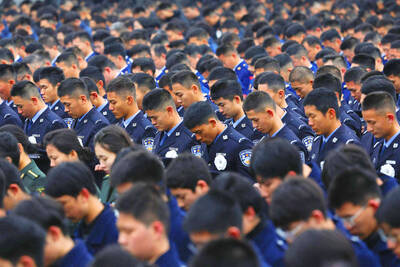The Dutch government said on Monday it would set aside more than US$520 million to combat terrorism in coming years, citing threats to national security in the wake of attacks in Europe by Muslim extremists.
The money will be used over the next five years to boost the number of employees at the national Intelligence Service by 10 percent to more than 1,000. Hundreds of new positions will also be added at the National Police Service, Military Police and other intelligence services.
Justice Minister Piet Hein Donner said attacks like the Madrid train bombings and the murder by an Islamic radical of Dutch filmmaker Theo van Gogh in November were "the reason to allocate extra resources to fight terrorism."
The Intelligence Service, known by its Dutch acronym AIVD, will gain 350 new staff members by 2009 and will have an additional US$140 million in funding, on top of an extra US$13 million already allocated to fight terrorism. In 2003, the service's budget was nearly US$100 million.
"In the past year, the Netherlands has been confronted with the threat of international terrorism, which became acute with the attacks on March 11 [in Madrid]," Donner said, detailing a letter on the measures sent to parliament on Monday.
The Intelligence Service issued repeated warnings last year which led to heightened protection of politicians and national landmarks, such as Schiphol International Airport.
About 800 new jobs will be created overall, including 60 security agents to protect threatened politicians. In an attempt to stop the radicalization of thousands of Muslim youths, judges will be granted powers to bar Muslim imams or preachers who "incited hate or violence," Donner said.
Donner also proposed new legislation to enable law enforcement officials to act against suspects before they have committed a crime.
"Certain individuals will be banned from visiting certain objects or nearing certain persons," a statement issued by the Justice Ministry said.
The proposal was approved by the Cabinet on Friday.
Donner said it was intended for individuals who are considered a potential threat, such as suspected recruits for the Islamic jihad, or holy war, known to have trained at camps in Pakistan or elsewhere.
"An example could be if someone spent time at a training camp, but I don't have enough to charge them with a crime," he said.
He gave the example of Mohammed Bouyeri, the 26-year-old suspect in Van Gogh's murder, who was believed to have associated with members of a terrorist network in the Netherlands plotting attacks against politicians.
Asked if the measures infringed on civil liberties, Donner agreed they "go pretty far," but countered that they were justified in the wake of new terrorist threats.

PARLIAMENT CHAOS: Police forcibly removed Brazilian Deputy Glauber Braga after he called the legislation part of a ‘coup offensive’ and occupied the speaker’s chair Brazil’s lower house of Congress early yesterday approved a bill that could slash former Brazilian president Jair Bolsonaro’s prison sentence for plotting a coup, after efforts by a lawmaker to disrupt the proceedings sparked chaos in parliament. Bolsonaro has been serving a 27-year term since last month after his conviction for a scheme to stop Brazilian President Luiz Inacio Lula da Silva from taking office after the 2022 election. Lawmakers had been discussing a bill that would significantly reduce sentences for several crimes, including attempting a coup d’etat — opening up the prospect that Bolsonaro, 70, could have his sentence cut to

China yesterday held a low-key memorial ceremony for the 1937 Nanjing Massacre, with Chinese President Xi Jinping (習近平) not attending, despite a diplomatic crisis between Beijing and Tokyo over Taiwan. Beijing has raged at Tokyo since Japanese Prime Minister Sanae Takaichi last month said that a hypothetical Chinese attack on Taiwan could trigger a military response from Japan. China and Japan have long sparred over their painful history. China consistently reminds its people of the 1937 Nanjing Massacre, in which it says Japanese troops killed 300,000 people in what was then its capital. A post-World War II Allied tribunal put the death toll

A passerby could hear the cacophony from miles away in the Argentine capital, the unmistakable sound of 2,397 dogs barking — and breaking the unofficial world record for the largest-ever gathering of golden retrievers. Excitement pulsed through Bosques de Palermo, a sprawling park in Buenos Aires, as golden retriever-owners from all over Argentina transformed the park’s grassy expanse into a sea of bright yellow fur. Dog owners of all ages, their clothes covered in dog hair and stained with slobber, plopped down on picnic blankets with their beloved goldens to take in the surreal sight of so many other, exceptionally similar-looking ones.

‘UNWAVERING ALLIANCE’: The US Department of State said that China’s actions during military drills with Russia were not conducive to regional peace and stability The US on Tuesday criticized China over alleged radar deployments against Japanese military aircraft during a training exercise last week, while Tokyo and Seoul yesterday scrambled jets after Chinese and Russian military aircraft conducted joint patrols near the two countries. The incidents came after Japanese Prime Minister Sanae Takaichi triggered a dispute with Beijing last month with her remarks on how Tokyo might react to a hypothetical Chinese attack on Taiwan. “China’s actions are not conducive to regional peace and stability,” a US Department of State spokesperson said late on Tuesday, referring to the radar incident. “The US-Japan alliance is stronger and more